Air Quality Analysis in Lima, Peru Using the NO2 Levels during the COVID-19 Pandemic Lockdown
Abstract
:1. Introduction
2. Materials and Methods
2.1. Data Acquisition
2.1.1. Copernicus Sentinel-5 Precursor
- Temporal coverage: since 30 April 2018.
- Spatial coverage: about a 2600 km swath. Full daily surface coverage of radiance and reflectance measurements for latitudes over 7° and under −7°, and better than 95% coverage for latitudes in the interval [−7°, 7°].
- Spatial resolution: 3.5 × 7.0 km (across by along-track), at the beginning of the mission and 3.5 × 5.5 km (across by along-track), since 6 August 2019.
- Orbit: near-polar, sun-synchronous orbit with an ascending node equatorial crossing at 13:30 h Mean Local Solar time. The surface is always illuminated at the same sun angle in a sun-synchronous orbit [38].
2.1.2. Google Earth Engine
2.2. Process
- 1.
- Location of geographic coordinates for a specific point in Lima. The function ’Geometry point’ of GEE was used to import each point’s longitude and latitude described in Section 2.1.2 [41].
- 2.
- Assign 500 m diametrical buffer around the specific point. Around each coordinate previously set, a buffer of 500 m diameter was added to extract the NO data only around that area to later export data and apply a statistical reducer [42].
- 3.
- Load the Copernicus Sentinel-5P satellite image collection product L3/NO. GEE has various satellite data collections; for this specific research, the Sentinel-5P OFFL NO: Offline Nitrogen Dioxide dataset was used to obtain the density values of NO. This is described in a particular band of a total vertical column of NO (ratio of the slant column density of NO and the total air mass factor; see [43] for more details about the bands in the Sentinel-5P satellite):
| var collection = ee.ImageCollection (’COPERNICUS/S5P/OFFL/L3_NO2’). selec (’tropospheric_NO2_column_number_density’). filterDate(’2020-01-01’, ’2020-06-30’) |
- 4.
- Clipping of satellite images to only show NO data in the region of interest. Satellite data are clipped to the buffer area delimited in step 2 around each coordinate in order to compile the statistical analysis [42]:
| var geom=geometry.buffer(500); var timeSeries2019 = collection2019.map(function (image) { var date = image.date().format(’yyyy-MM-dd’) var value = image .clip(geom) .reduceRegion({ reducer: ee.Reducer.mean(), scale: 30 }).get(’tropospheric_NO2_column_number_density’) return ee.Feature(null, {value: value, date: date}) }) //Show rectangle around ROI var Parada2020=collection.median().clip(geometry2) |
- 5.
- Color palette application to graphically differentiate NO concentrations on a scale of a minimum value of 0 and a maximum value of 0.0002 mol/m with a total of seven levels colored from white to red [42]:
| var band_viz = { min: 0, max: 0.0002, palette: [’white’, ’blue’, ’purple’, ’cyan’, ’green’, ’yellow’, ’red’], opacity: 0.3 } |
- 6.
- Application of statistical reducer of the mean to obtain a single value of NO per established date. A reducer is a way to aggregate GEE data within the buffer area to obtain a single value of the NO density level [44]:
| var timeSeries = collection.map(function (image) { var date = image.date().format(’yyyy-MM-dd’) var value = image .clip(geom) .reduceRegion({ reducer: ee.Reducer.mean(), scale: 30 }).get(’tropospheric_NO2_column_number_density’) return ee.Feature(null, {value: value, date: date}) }) |
- 7.
- Export data in CSV format for future statistical analysis. When the reducer is applied, now we can export the data in CSV format to further enhance the statistical analysis and comparison within zones and time [45]:
| Export.table.toDrive({ collection: timeSeries, description: ’NO2Levels2020MercadoFrutas’, selectors: ’date, value’, fileFormat: ’CSV’ }); |
2.3. Visual Representation of the Data
3. Results and Discussion
3.1. Comparison with Official Ground Air Quality Monitoring Stations
3.2. Satellite Results and Discussion
4. Conclusions
Author Contributions
Funding
Institutional Review Board Statement
Informed Consent Statement
Data Availability Statement
Conflicts of Interest
References
- The World Bank. Poverty Headcount Ratio at National Poverty Lines (% of Population). Peru. 2020. Available online: https://data.worldbank.org/indicator/SI.POV.NAHC?locations=PE (accessed on 21 February 2022).
- Finn, K. The Informal Economy in Peru: A Blueprint for Systemic Reform. Lehigh Preserv. 2017, 35, 56–57. [Google Scholar]
- French, A.; Mechler, R.; Arestegui, M.; MacClune, K.; Cisneros, A. Root causes of recurrent catastrophe: The political ecology of El Niño-related disasters in Peru. Int. J. Disaster Risk Reduct. 2020, 47, 101539. [Google Scholar] [CrossRef]
- Rodríguez-Urrego, D.; Rodríguez-Urrego, L. Air quality during the COVID-19: PM2.5 analysis in the 50 most polluted capital cities in the world. Environ. Pollut. 2020, 266, 115042. [Google Scholar] [CrossRef]
- Horton, J. COVID: Why Has Peru Been So Badly Hit? 2020. Available online: https://www.bbc.com/news/world-latin-america-53150808 (accessed on 21 February 2022).
- World Health Organization. Air Quality Guidelines: Global Update 2005: Particulate Matter, Ozone, Nitrogen Dioxide, and Sulfur Dioxide; Technical Report; World Health Organization: Copenhagen, Denmark, 2006. [Google Scholar]
- Carvalho, P.C.; Nakazato, L.F.; Nascimento, L.F.C. Exposure to NO2 and children hospitalization due to respiratory diseases in Ribeirão Preto, SP, Brazil. Cienc. Saude Coletiva 2018, 23, 2515–2522. [Google Scholar] [CrossRef]
- Esposito, S.; Galeone, C.; Lelii, M.; Longhi, B.; Ascolese, B.; Senatore, L.; Prada, E.; Montinaro, V.; Malerba, S.; Patria, M.F.; et al. Impact of air pollution on respiratory diseases in children with recurrent wheezing or asthma. BMC Pulm. Med. 2014, 14, 130. [Google Scholar] [CrossRef] [Green Version]
- Song, Y.; Chen, F.; Zhang, Y.; Zhang, S.; Liu, F.; Sun, P.; Yan, X.; Lu, G. Fabrication of highly sensitive and selective room-temperature nitrogen dioxide sensors based on the ZnO nanoflowers. Sens. Actuators B Chem. 2019, 287, 191–198. [Google Scholar] [CrossRef]
- Bao, R.; Zhang, A. Does lockdown reduce air pollution? Evidence from 44 cities in northern China. Sci. Total Environ. 2020, 731, 139052. [Google Scholar] [CrossRef]
- Collivignarelli, M.C.; Abbà, A.; Bertanza, G.; Pedrazzani, R.; Ricciardi, P.; Carnevale Miino, M. Lockdown for CoViD-2019 in Milan: What are the effects on air quality? Sci. Total Environ. 2020, 732, 139280. [Google Scholar] [CrossRef] [PubMed]
- Tobías, A.; Carnerero, C.; Reche, C.; Massagué, J.; Via, M.; Minguillón, M.C.; Alastuey, A.; Querol, X. Changes in air quality during the lockdown in Barcelona (Spain) one month into the SARS-CoV-2 epidemic. Sci. Total Environ. 2020, 726, 138540. [Google Scholar] [CrossRef]
- ESA Copernicus Sentinel. Sentinel-5P. 2020. Available online: https://sentinels.copernicus.eu/web/sentinel/missions/sentinel-5p (accessed on 21 February 2022).
- Roman-Gonzalez, A.; Navarro-Raymundo, A.F.; Vargas-Cuentas, N.I. Air Pollution Monitoring in Peru Using Satellite Data During the Quarantine Due to COVID-19. IEEE Aerosp. Electron. Syst. Mag. 2020, 35, 73–79. [Google Scholar] [CrossRef]
- Arias Velásquez, R.M.; Mejía Lara, J.V. Gaussian approach for probability and correlation between the number of COVID-19 cases and the air pollution in Lima. Urban Clim. 2020, 33, 100664. [Google Scholar] [CrossRef] [PubMed]
- Badillo-Rivera, E.; Fow-Esteves, A.; Alata-López, F.; Virú-Vásquez, P.; Medina-Acuña, M. Environmental and social analysis as risk factors for the spread of the novel coronavirus (SARS-CoV-2) using remote sensing, GIS and analytical hierarchy process (AHP): Case of Peru. medRxiv 2020. [Google Scholar] [CrossRef]
- Fan, C.; Li, Y.; Guang, J.; Li, Z.; Elnashar, A.; Allam, M.; de Leeuw, G. The Impact of the Control Measures during the COVID-19 Outbreak on Air Pollution in China. Remote Sens. 2020, 12, 1613. [Google Scholar] [CrossRef]
- Kumari, P.; Toshniwal, D. Impact of lockdown measures during COVID-19 on air quality—A case study of India. Int. J. Environ. Health Res. 2020, 32, 503–510. [Google Scholar] [CrossRef] [PubMed]
- Venter, Z.S.; Aunan, K.; Chowdhury, S.; Lelieveld, J. COVID-19 lockdowns cause global air pollution declines. Proc. Natl. Acad. Sci. USA 2020, 117, 18984–18990. [Google Scholar] [CrossRef]
- Stratoulias, D.; Nuthammachot, N. Air quality development during the COVID-19 pandemic over a medium-sized urban area in Thailand. Sci. Total Environ. 2020, 746, 141320. [Google Scholar] [CrossRef]
- Gamelas, C.; Abecasis, L.; Canha, N.; Almeida, S.M. The Impact of COVID-19 Confinement Measures on the Air Quality in an Urban-Industrial Area of Portugal. Atmosphere 2021, 12, 1097. [Google Scholar] [CrossRef]
- Turek, T.; Diakowska, E.; Kamińska, J.A. Has COVID-19 Lockdown Affected on Air Quality?—Different Time Scale Case Study in Wrocław, Poland. Atmosphere 2021, 12, 1549. [Google Scholar] [CrossRef]
- Ghasempour, F.; Sekertekin, A.; Kutoglu, S.H. Google Earth Engine based spatio-temporal analysis of air pollutants before and during the first wave COVID-19 outbreak over Turkey via remote sensing. J. Clean. Prod. 2021, 319, 128599. [Google Scholar] [CrossRef]
- Mendez-Espinosa, J.F.; Rojas, N.Y.; Vargas, J.; Pachón, J.E.; Belalcazar, L.C.; Ramírez, O. Air quality variations in Northern South America during the COVID-19 lockdown. Sci. Total Environ. 2020, 749, 141621. [Google Scholar] [CrossRef]
- Shrestha, A.M.; Shrestha, U.B.; Sharma, R.; Bhattarai, S.; Tran, H.N.T.; Rupakheti, M. Lockdown caused by COVID-19 pandemic reduces air pollution in cities worldwide. EarthArXiv 2020. [Google Scholar] [CrossRef]
- Pacheco, H.; Díaz-López, S.; Jarre, E.; Pacheco, H.; Méndez, W.; Zamora-Ledezma, E. NO2 levels after the COVID-19 lockdown in Ecuador: A trade-off between environment and human health. Urban Clim. 2020, 34, 100674. [Google Scholar] [CrossRef] [PubMed]
- Oo, T.K.; Arunrat, N.; Kongsurakan, P.; Sereenonchai, S.; Wang, C. Nitrogen Dioxide (NO2) Level Changes during the Control of COVID-19 Pandemic in Thailand. Aerosol Air Quality Res. 2021, 21, 200440. [Google Scholar] [CrossRef]
- Skiriene, A.F.; Stasiskiene, Z. COVID-19 and Air Pollution: Measuring Pandemic Impact to Air Quality in Five European Countries. Atmosphere 2021, 12, 290. [Google Scholar] [CrossRef]
- Bassani, C.; Vichi, F.; Esposito, G.; Montagnoli, M.; Giusto, M.; Ianniello, A. Nitrogen dioxide reductions from satellite and surface observations during COVID-19 mitigation in Rome (Italy). Environ. Sci. Pollut. Res. 2021, 28, 22981–23004. [Google Scholar] [CrossRef]
- Akritidis, D.; Zanis, P.; Georgoulias, A.K.; Papakosta, E.; Tzoumaka, P.; Kelessis, A. Implications of COVID-19 Restriction Measures in Urban Air Quality of Thessaloniki, Greece: A Machine Learning Approach. Atmosphere 2021, 12, 1500. [Google Scholar] [CrossRef]
- Ogen, Y. Assessing nitrogen dioxide (NO2) levels as a contributing factor to coronavirus (COVID-19) fatality. Sci. Total Environ. 2020, 726, 138605. [Google Scholar] [CrossRef]
- Chudnovsky, A.A. Letter to editor regarding Ogen Y 2020 paper: “Assessing nitrogen dioxide (NO2) levels as a contributing factor to coronavirus (COVID-19) fatality”. Sci. Total Environ. 2020, 740, 139236. [Google Scholar] [CrossRef]
- Worldometers.info. COVID-19 CORONAVIRUS PANDEMIC. 2021. Available online: https://www.worldometers.info/coronavirus/ (accessed on 21 February 2022).
- Lee, K.; Greenstone, M. Air Quality Life Index: Annual Update; Air Quality Life Index: Chicago, IL, USA, 2021. [Google Scholar]
- Google Earth Engine. A Planetary-Scale Platform for Earth Science Data & Analysis. 2021. Available online: https://earthengine.google.com (accessed on 21 February 2022).
- ESA Copernicus Sentinel. Sentinel-5P TROPOMI User Guide. 2020. Available online: https://sentinel.esa.int/web/sentinel/user-guides/sentinel-5p-tropomi (accessed on 21 February 2022).
- ESA Copernicus Sentinel. Copernicus Sentinel-5P Data Products. 2021. Available online: https://sentinels.copernicus.eu/web/sentinel/missions/sentinel-5p/data-products (accessed on 21 February 2022).
- Agency, E.S. Sentinel-5P: Orbit. 2021. Available online: https://sentinels.copernicus.eu/web/sentinel/missions/sentinel-5p/orbit (accessed on 21 February 2022).
- Google Earth Engine. Google Earth Engine Developer’s Guide. 2021. Available online: https://developers.google.com/earth-engine (accessed on 21 February 2022).
- The World Air Quality Project. Lima Air Pollution: Real-time Air Quality Index (AQI). 2021. Available online: https://aqicn.org/city/lima/ (accessed on 21 February 2022).
- Google Earth Engine. Geometry Overview. 2021. Available online: https://developers.google.com/earth-engine/guides/geometries (accessed on 21 February 2022).
- Google Earth Engine. Image Visualization. 2021. Available online: https://developers.google.com/earth-engine/guides/image_visualization (accessed on 21 February 2022).
- Google Earth Engine. Sentinel-5P OFFL NO2: Offline Nitrogen Dioxide. 2021. Available online: https://developers.google.com/earthengine/datasets/catalog/COPERNICUSS5POFFLL3NO2 (accessed on 21 February 2022).
- Google Earth Engine. Reducer Overview. 2021. Available online: https://developers.google.com/earth-engine/guides/reducers_intro (accessed on 21 February 2022).
- Google Earth Engine. Exporting Data. 2021. Available online: https://developers.google.com/earth-engine/guides/exporting (accessed on 21 February 2022).
- Schafer, R.W. What Is a Savitzky-Golay Filter? [Lecture Notes]. IEEE Signal Process. Mag. 2011, 28, 111–117. [Google Scholar] [CrossRef]
- Betta, G.; Capriglione, D.; Cerro, G.; Ferrigno, L.; Miele, G. The effectiveness of Savitzky-Golay smoothing method for spectrum sensing in cognitive radios. In Proceedings of the 2015 XVIII AISEM Annual Conference, Trento, Italy, 3–5 February 2015; pp. 1–4. [Google Scholar] [CrossRef]
- Schober, P.; Boer, C.; Schwarte, L.A. Correlation Coefficients: Appropriate Use and Interpretation. Anesth. Analg. 2018, 126, 1763–1768. [Google Scholar] [CrossRef]
- Ratner, B. The correlation coefficient: Its values range between+ 1/−1, or do they? J. Target. Meas. Analy. Market. 2009, 17, 139–142. [Google Scholar] [CrossRef] [Green Version]
- Marinello, S.; Butturi, M.A.; Gamberini, R. How changes in human activities during the lockdown impacted air quality parameters: A review. Environ. Prog. Sustain. Energy 2021, 40, e13672. [Google Scholar] [CrossRef] [PubMed]
- Peru News Agency. Peru: Government Extends State of Emergency against Covid-19 Thru June 30; Technical Report; Andina Agencia Peruana de Noticias: Lima, Peru, 2020. [Google Scholar]
- Jabiel, S.; Life Helmets. Technical Report; United Nations Development Programme. 2020. Available online: https://www.pe.undp.org/content/peru/es/home/presscenter/articles/2020/life-helmets.html (accessed on 21 February 2022).
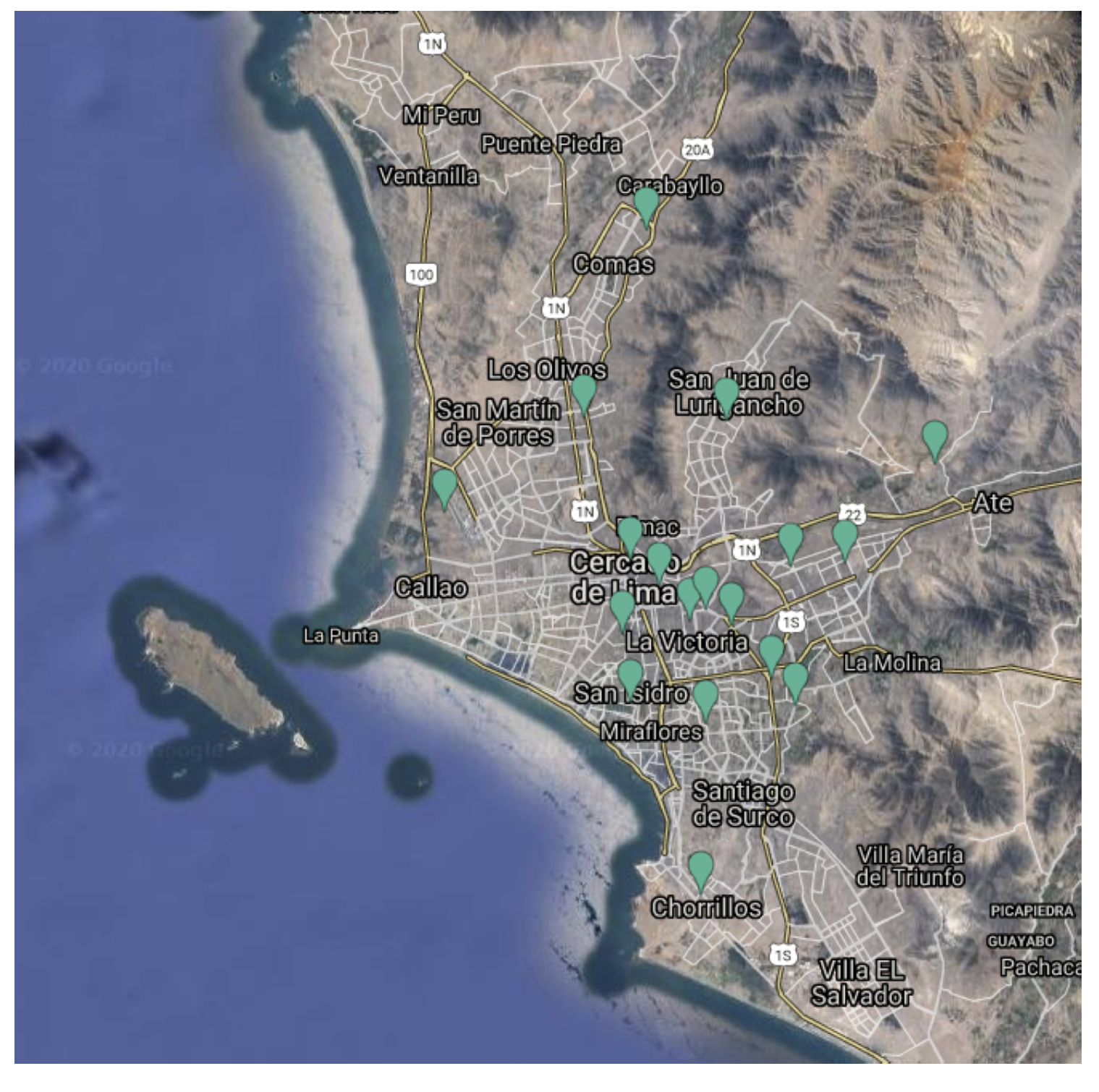
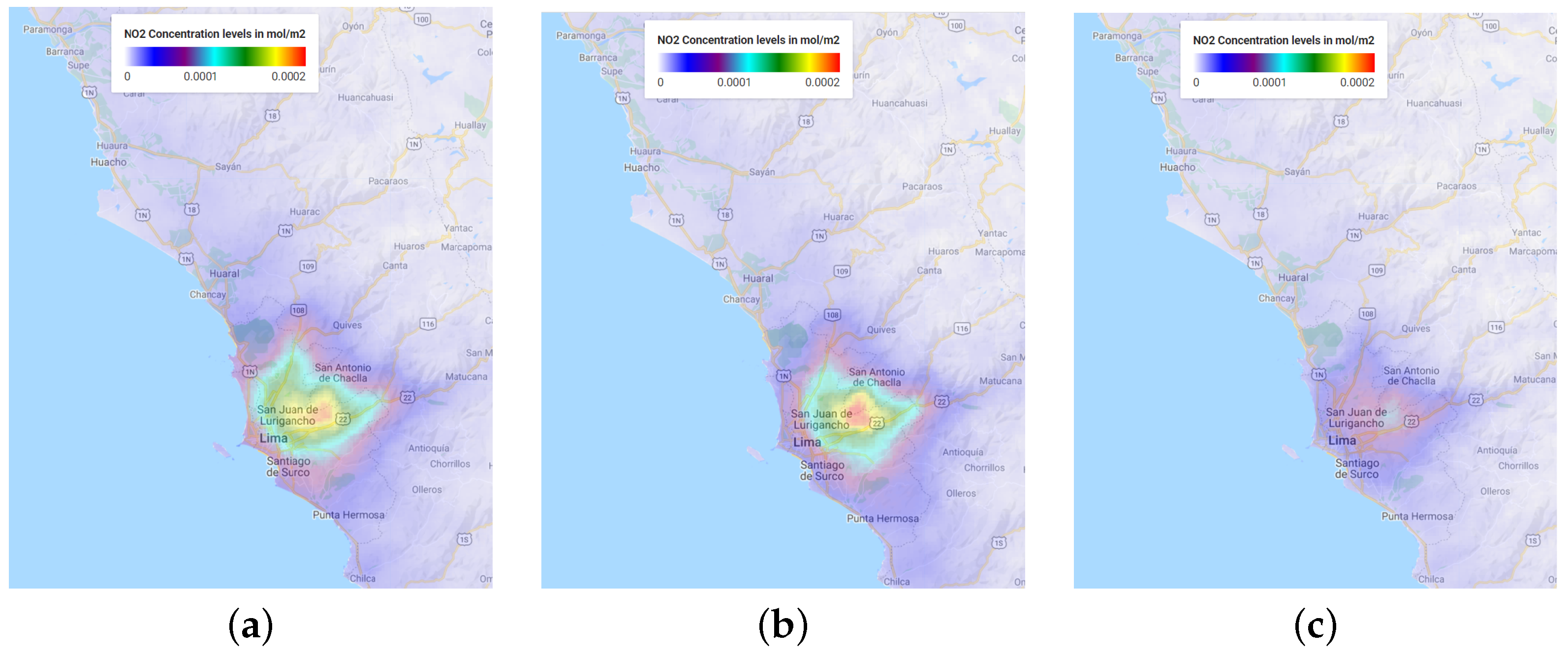

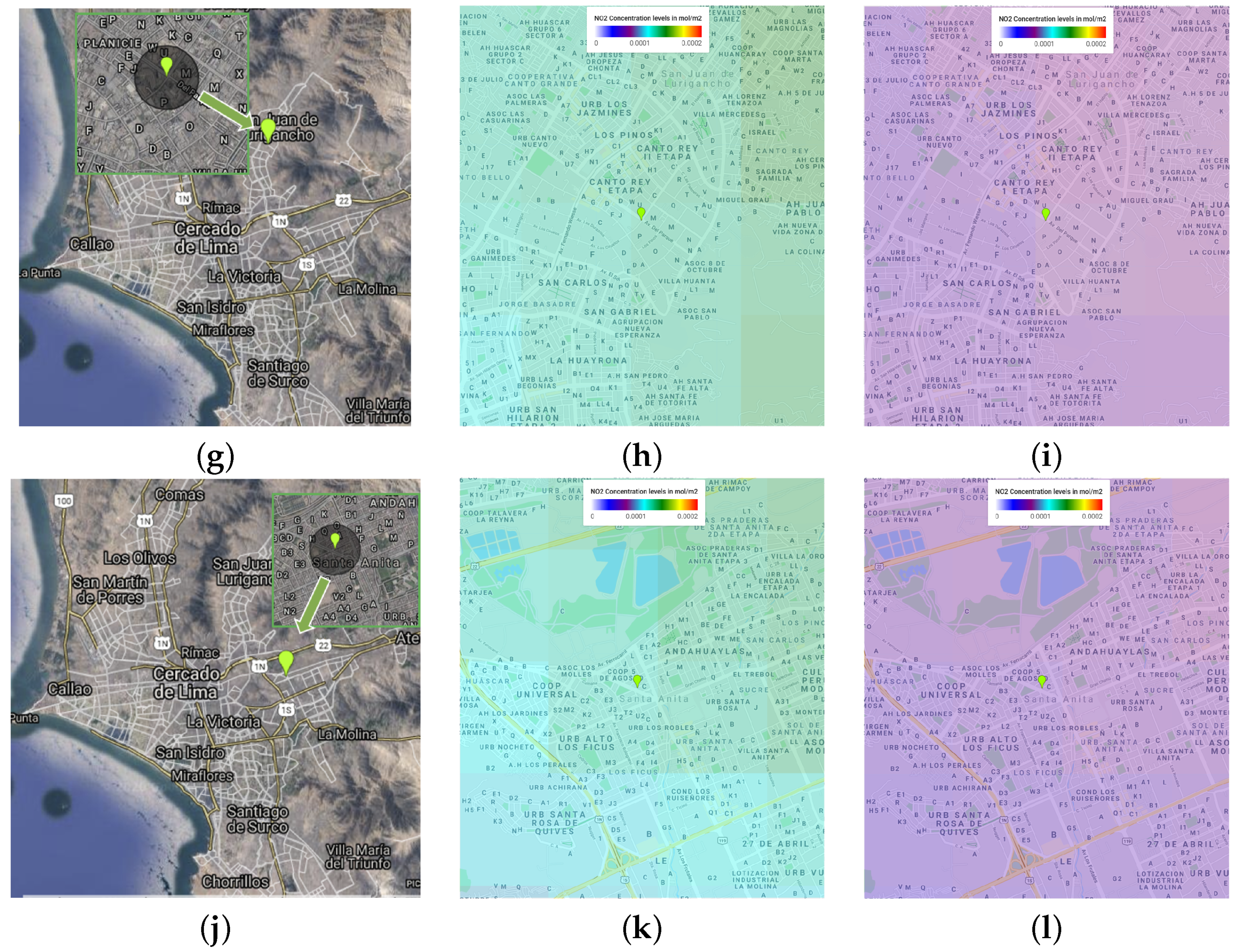
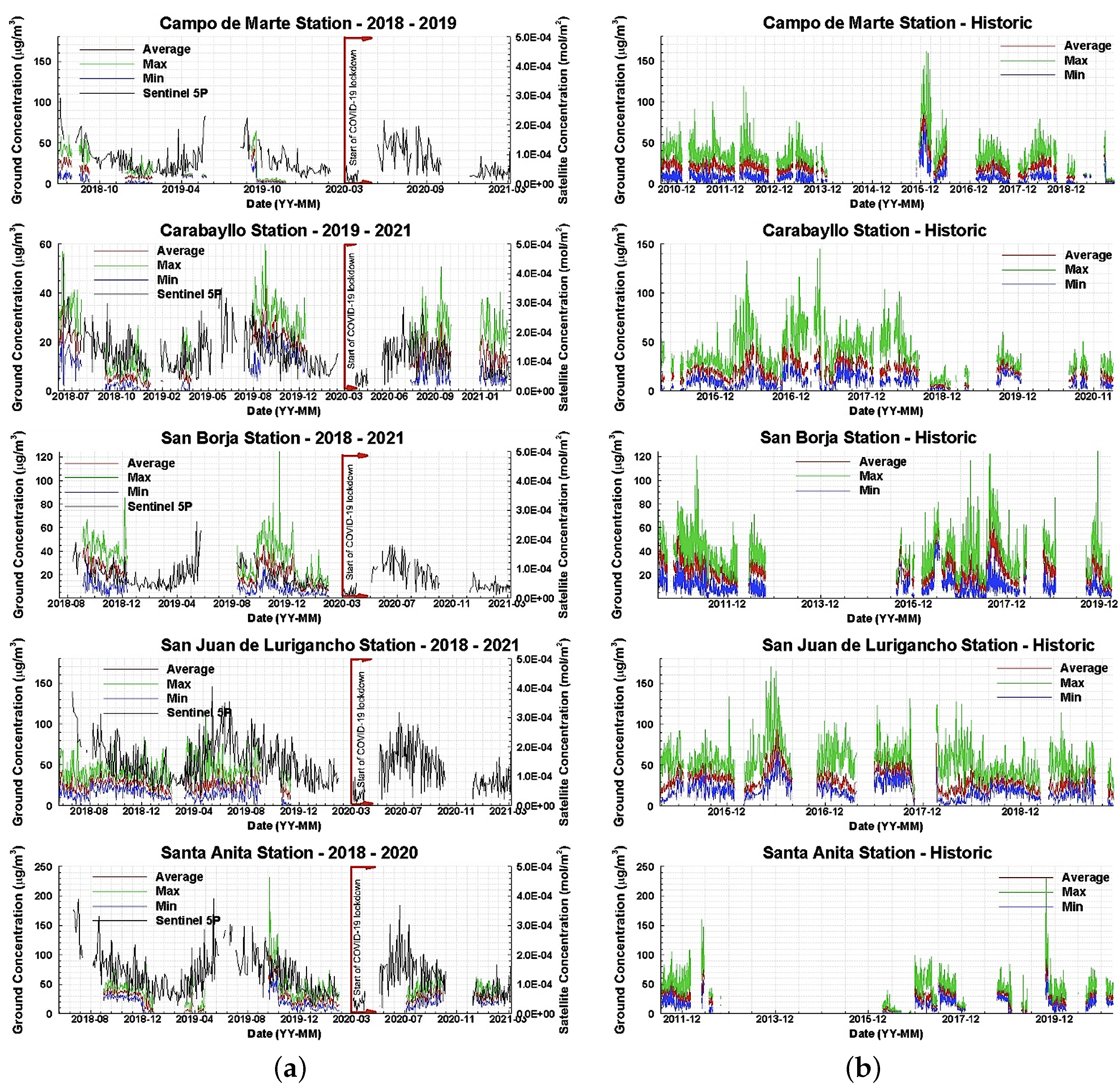
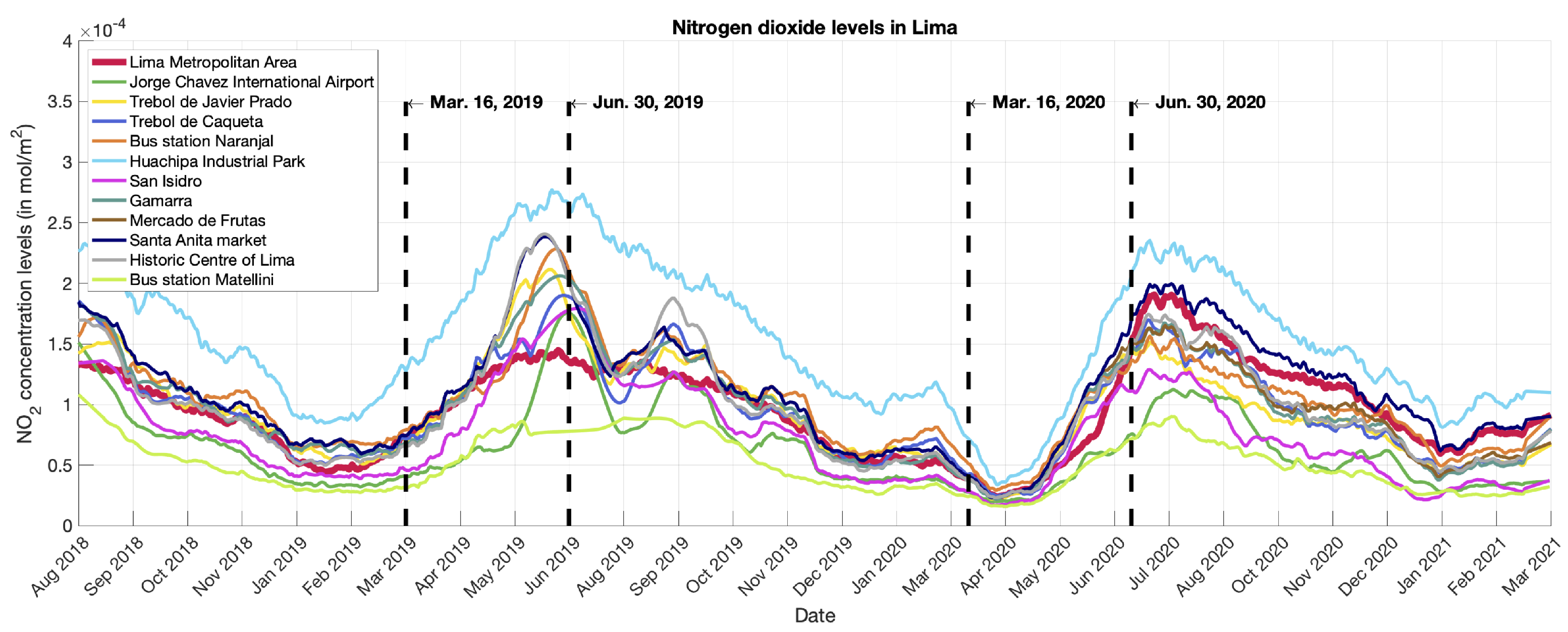

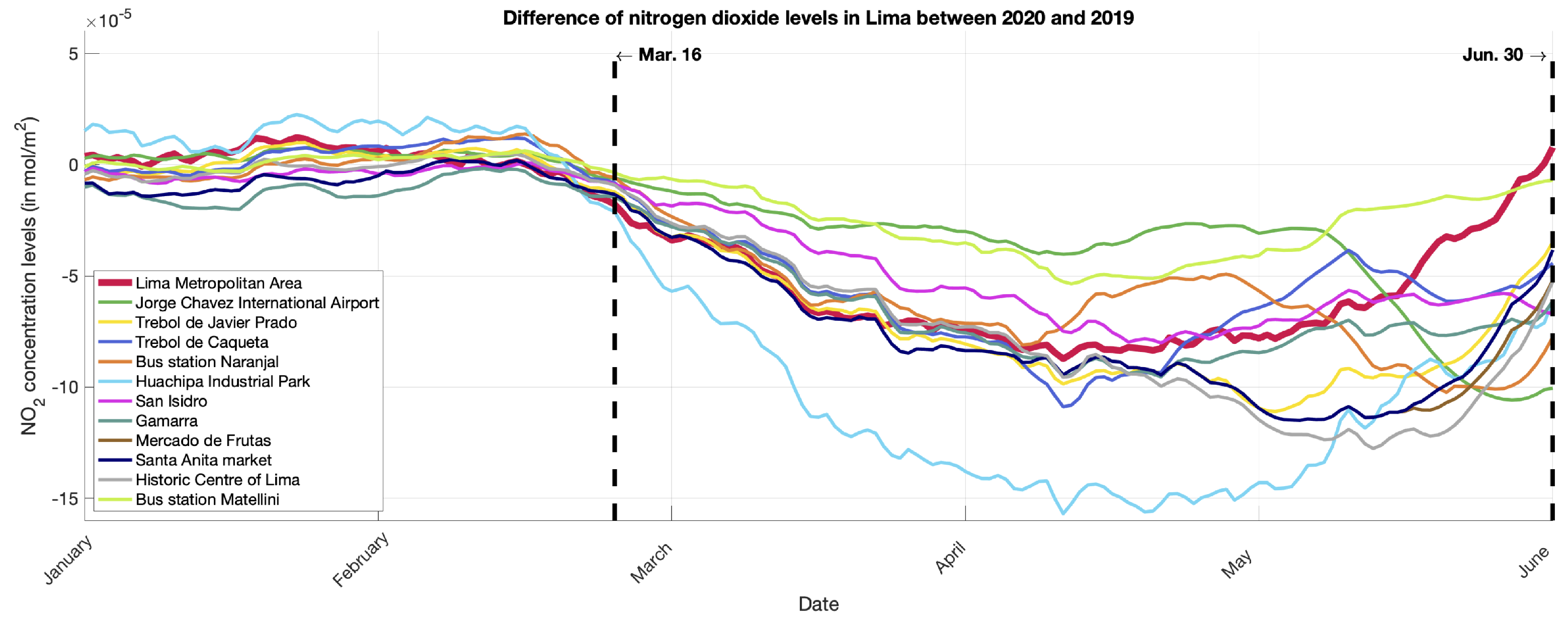
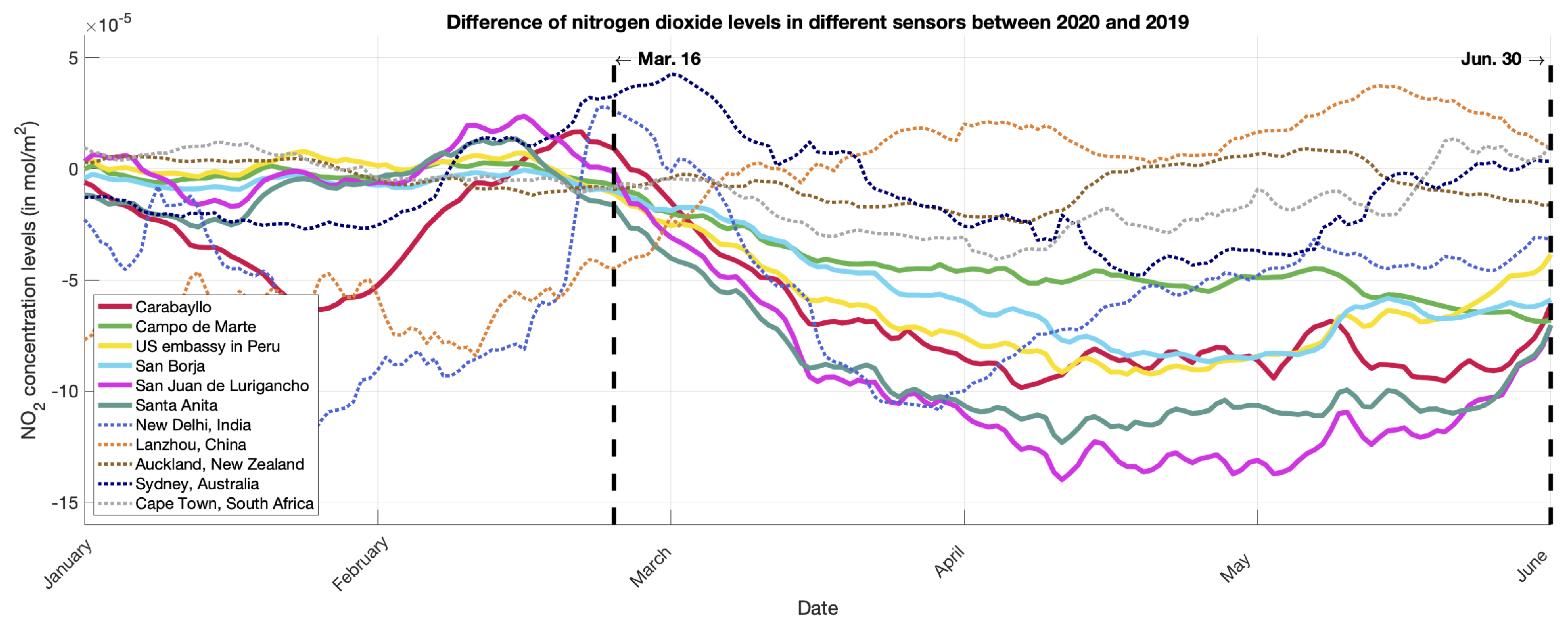
| Place | Comments | Latitude and Longitude Coordinates | |
|---|---|---|---|
| 1 | Lima metropolitan area | Downtown Lima | −77.04, −12.04 |
| 2 | Jorge Chavez International Airport | Peru’s main international and domestic airport | −77.12, −12.02 |
| 3 | Gamarra Commercial Emporium | Popularly known as Gamarra, place of great commercial movement mainly related to the fashion industry and the manufacture of clothing | −77.01, −12.06 |
| 4 | Bus station ‘Matellini’ | One of Lima’s main metro stations | −77.01, −12.18 |
| 5 | ‘El mercado de frutas’ | Main fruit market in Lima | −76.99, −12.06 |
| 6 | ‘Santa Anita’ market | One big wholesale market in Lima | −76.94, −12.04 |
| 7 | Bus station ‘Naranjal’ | One of Lima’s busiest bus stations | −77.06, −11.98 |
| 8 | ‘San Isidro’ | District is one of Lima’s wealthiest neighborhoods | −77.04, −12.1 |
| 9 | ‘Trebol de Caqueta’ | One of the busiest road interchanges in Lima | −77.04, −12.04 |
| 10 | ‘Trebol de Javier Prado’ | Well-known road interchanges in Lima | −76.98, −12.09 |
| 11 | Historic Centre of Lima | District with the main public entities | −77.02, −12.05 |
| 12 | Huachipa Industrial Park | Industrial district in the province of Lima | −76.91, −12.00 |
| 13 | ‘Campo de Marte’ | Location of a National Meteorology and Hydrology Service of Peru (SENAMHI) official air quality sensor | −77.04, −12.07 |
| 14 | ‘Carabayllo’ | Location of a SENAMHI official air quality sensor | −77.03, −11.90 |
| 15 | US embassy in Peru | Location of a SENAMHI official air quality sensor | −76.96, −12.10 |
| 16 | ‘San Juan de Lurigancho’ (SJL) | Location of a SENAMHI official air quality sensor | −76.99, −11.98 |
| 17 | ‘San Borja’ | Location of a SENAMHI official air quality sensor | −77.00, −12.10 |
| 18 | ‘Santa Anita’ | Location of a SENAMHI official air quality sensor | −76.97, −12.04 |
| Ground Station | Sentinel-5P | Pearson Correlation Coefficient: Sentinel-5P with | ||||||
|---|---|---|---|---|---|---|---|---|
| Station Name | Range of Dates | Number of Data Points | Range of Dates | Number of Data Points | Number of Common Data Points | Daily Average | Daily Maximum | Daily Minimum |
| Campo de Marte | Aug. 2010–Nov. 2019 | 1830 | Jul. 2018–Mar. 2021 | 360 | 82 | 0.482 | 0.393 | 0.345 |
| Carabayllo | Mar. 2015–Mar. 2021 | 1273 | Jun. 2018–Mar. 2021 | 458 | 208 | 0.301 | 0.327 | 0.209 |
| San Borja | Jun. 2010–Feb. 2020 | 1758 | Aug. 2018–Mar. 2021 | 379 | 123 | 0.547 | 0.487 | 0.313 |
| San Juan de Lurigancho | Mar. 2015–Nov. 2019 | 1272 | Jun. 2018–Mar. 2021 | 509 | 215 | 0.413 | 0.289 | 0.298 |
| Santa Anita | Jun. 2011–Mar. 2021 | 1234 | Jun. 2018–Mar. 2021 | 491 | 285 | 0.251 | 0.173 | 0.241 |
| 16 March–29 March | 30 March–15 April | ||||||||||||
|---|---|---|---|---|---|---|---|---|---|---|---|---|---|
| Location | 2019 | 2020 | 2021 | 2020:2019 | 2020:2021 | 2019 | 2020 | 2020:2019 | |||||
| min. | min. | min. | % () | % () | min. | min. | % () | ||||||
| Lima Metropolitan Area | 7.2 | 7.9 | 2.7 | 3.6 | 8.3 | 8.7 | 45.6 | 41.4 | 9.0 | 9.5 | 2.4 | 2.6 | 27.4 |
| Jorge Chavez Int. Airport | 4.1 | 4.3 | 2.1 | 2.4 | 3.6 | 3.6 | 55.8 | 66.7 | 4.6 | 4.8 | 2.0 | 2.1 | 43.8 |
| Santa Anita market | 7.4 | 8.0 | 2.5 | 3.4 | 6.1 | 6.5 | 42.5 | 52.3 | 9.0 | 9.9 | 2.3 | 2.5 | 25.3 |
| Bus station Matellini | 3.1 | 3.4 | 1.7 | 2.1 | 2.9 | 3.1 | 61.8 | 67.7 | 3.9 | 4.5 | 1.6 | 1.7 | 37.8 |
Publisher’s Note: MDPI stays neutral with regard to jurisdictional claims in published maps and institutional affiliations. |
© 2022 by the authors. Licensee MDPI, Basel, Switzerland. This article is an open access article distributed under the terms and conditions of the Creative Commons Attribution (CC BY) license (https://creativecommons.org/licenses/by/4.0/).
Share and Cite
Velayarce, D.; Bustos, Q.; García, M.P.; Timaná, C.; Carbajal, R.; Salvatierra, N.; Horna, D.; Murray, V. Air Quality Analysis in Lima, Peru Using the NO2 Levels during the COVID-19 Pandemic Lockdown. Atmosphere 2022, 13, 373. https://doi.org/10.3390/atmos13030373
Velayarce D, Bustos Q, García MP, Timaná C, Carbajal R, Salvatierra N, Horna D, Murray V. Air Quality Analysis in Lima, Peru Using the NO2 Levels during the COVID-19 Pandemic Lockdown. Atmosphere. 2022; 13(3):373. https://doi.org/10.3390/atmos13030373
Chicago/Turabian StyleVelayarce, Diego, Qespisisa Bustos, Maria Paz García, Camila Timaná, Ricardo Carbajal, Noe Salvatierra, Daniel Horna, and Victor Murray. 2022. "Air Quality Analysis in Lima, Peru Using the NO2 Levels during the COVID-19 Pandemic Lockdown" Atmosphere 13, no. 3: 373. https://doi.org/10.3390/atmos13030373
APA StyleVelayarce, D., Bustos, Q., García, M. P., Timaná, C., Carbajal, R., Salvatierra, N., Horna, D., & Murray, V. (2022). Air Quality Analysis in Lima, Peru Using the NO2 Levels during the COVID-19 Pandemic Lockdown. Atmosphere, 13(3), 373. https://doi.org/10.3390/atmos13030373







